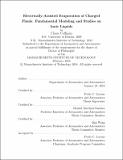| dc.contributor.advisor | Paulo C. Lozano. | en_US |
| dc.contributor.author | Coffman, Chase Spenser | en_US |
| dc.contributor.other | Massachusetts Institute of Technology. Department of Aeronautics and Astronautics. | en_US |
| dc.date.accessioned | 2016-07-01T18:22:28Z | |
| dc.date.available | 2016-07-01T18:22:28Z | |
| dc.date.copyright | 2016 | en_US |
| dc.date.issued | 2016 | en_US |
| dc.identifier.uri | http://hdl.handle.net/1721.1/103421 | |
| dc.description | Thesis: Ph. D., Massachusetts Institute of Technology, Department of Aeronautics and Astronautics, 2016. | en_US |
| dc.description | This electronic version was submitted by the student author. The certified thesis is available in the Institute Archives and Special Collections. | en_US |
| dc.description | Cataloged from student-submitted PDF version of thesis. | en_US |
| dc.description | Includes bibliographical references (pages 243-250). | en_US |
| dc.description.abstract | Electrosprays of the pure-ion variety embody a unique collection of attributes that have compelled interest in derivative technologies across a spectrum of applications ranging from Focused Ion Beams (FIB) to microrocketry. Unlike conventional colloid sources (i.e., so-called cone-jets or others sources from which droplets typically emanate), pure ion sprays are commonly characterized by narrow distributions of high specific charge and nominal energy deficits as a result of their evaporative mechanisms. Among other properties of the spray, these are known to enable well-behaved optics (e.g. for nanometric patterning with FIB) and low power overhead (e.g. for efficient electrical-to-kinetic energy transduction in microrocketry) while also providing for innate simplicity and spatial compactness. In spite of their potential for paradigm-shifting impact, the practicality of contemporary pure-ion sources has been tempered by issues relating to reliability and predictability. In contrast to droplet emission, for example, empirical studies strongly suggest that pure-ion modes are only permissible under special sets of circumstances and that important beam qualities (namely the stability but also the current) are sensitive functions of the meniscus configuration. The difficulty in controlling these modes is somewhat abated through the use of fluids like ionic liquids (IL), particularly in connection with several heuristics that have emerged, but the process remains substantially fickle. This is believed to owe most directly to an undeveloped physical understanding. While the physics that govern conventional colloid sources are at least functionally understood at this point, an analogous grasp of their ion relatives has proven elusive. The purpose of this thesis is to begin addressing this issue by way of rigorous theoretical investigations, with the ultimate aim of offering deeper fundamental insight and additional recourse to future design initiatives beyond the existing set of over-simplified heuristics. In this thesis we first conduct a survey of potential contributors to the very multi-physical phenomenon of charge evaporation and identify key influences through basic order-of-magnitude analyses. These are used to inform the formulation of a detailed mathematical framework that is subsequently leveraged in the exploration of evaporation behaviors for a prototypical ionic liquid meniscus across a range of field, media, and hydraulic conditions. The results uncover a previously uncharted family of highly-stressed but ostensibly stable solutions for the problem of a volumetrically-unconstrained source. These appear to be confined to a particular subregion of the global parameter space that emphasizes thoughtful sizing of the meniscus and architecting of the feeding system. The impedance aspect of the latter, in particular, is believed to play a critical role in steady emission when large scale disparities, which are common in practical settings, exist across the parent meniscus. Additional influences that are often neglected in the literature, such as that of the liquid permittivity, are also elucidated and shown to play meaningful roles in evaporation. We conclude by outlining a reasonably comprehensive set of conditions that should be met for steady emission and substantiate these with tangible evidence from our studies. | en_US |
| dc.description.statementofresponsibility | by Chase Coffman. | en_US |
| dc.format.extent | 250 pages | en_US |
| dc.language.iso | eng | en_US |
| dc.publisher | Massachusetts Institute of Technology | en_US |
| dc.rights | M.I.T. theses are protected by copyright. They may be viewed from this source for any purpose, but reproduction or distribution in any format is prohibited without written permission. See provided URL for inquiries about permission. | en_US |
| dc.rights.uri | http://dspace.mit.edu/handle/1721.1/7582 | en_US |
| dc.subject | Aeronautics and Astronautics. | en_US |
| dc.title | Electrically-assisted evaporation of charged fluids : fundamental modeling and studies on ionic liquids | en_US |
| dc.type | Thesis | en_US |
| dc.description.degree | Ph. D. | en_US |
| dc.contributor.department | Massachusetts Institute of Technology. Department of Aeronautics and Astronautics | |
| dc.identifier.oclc | 952096268 | en_US |
